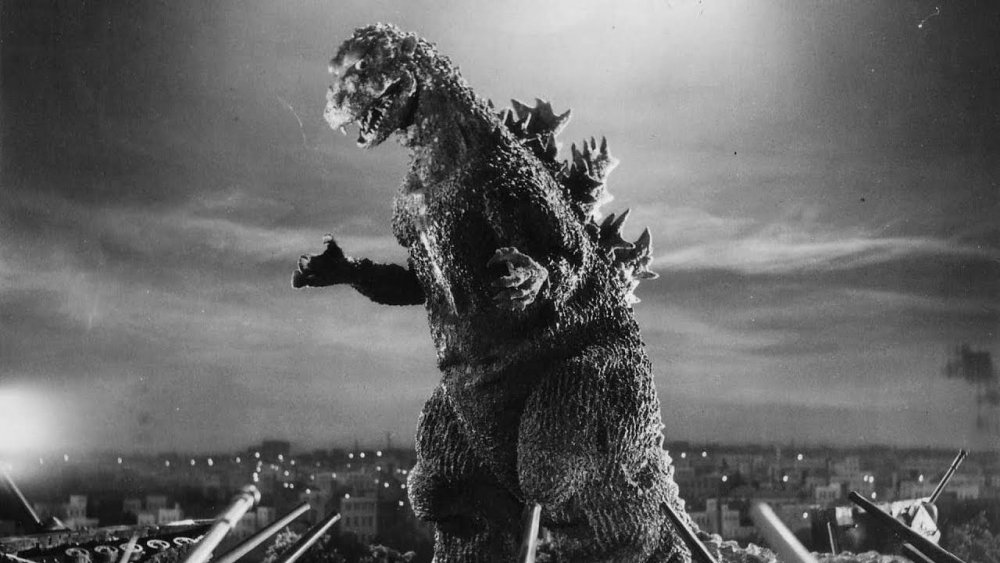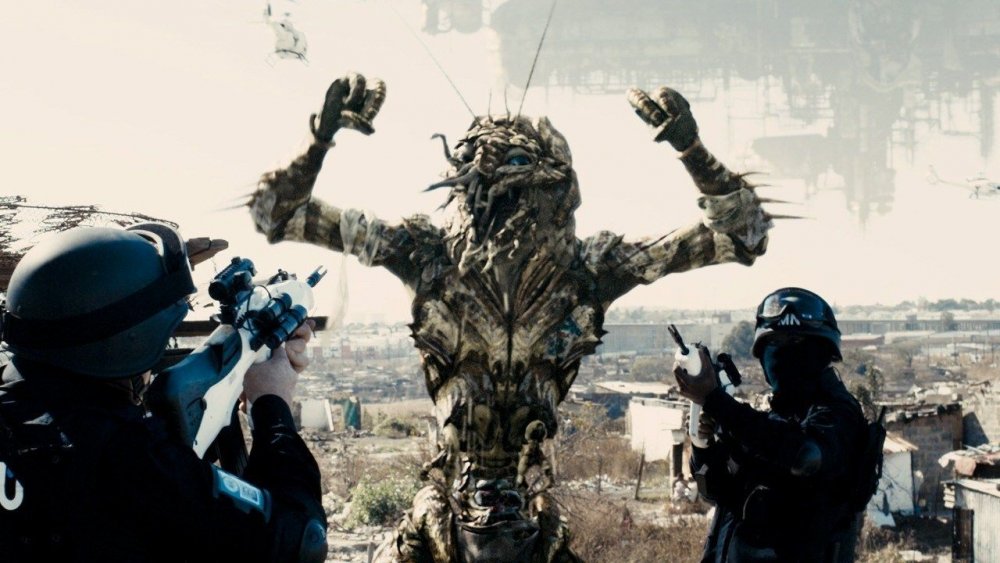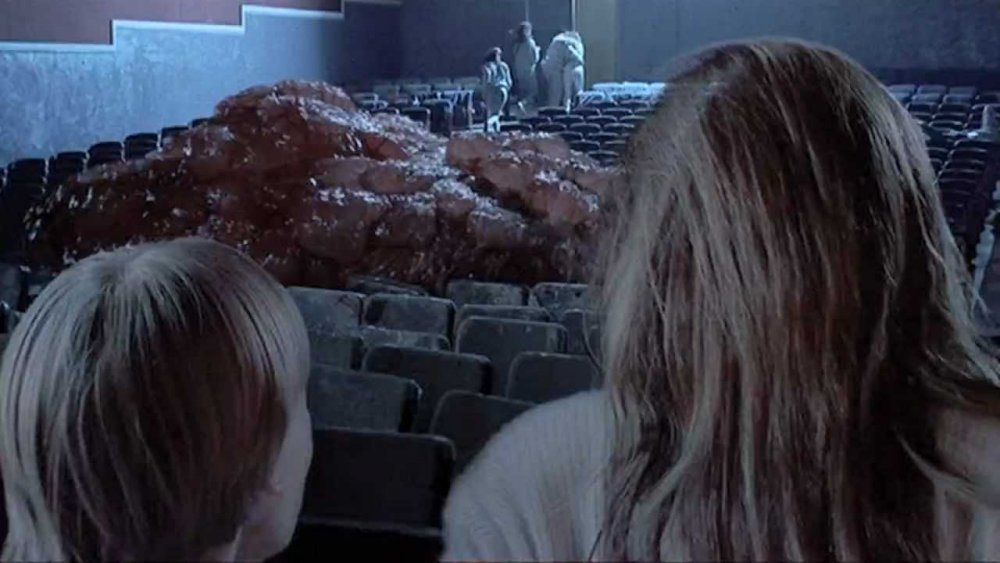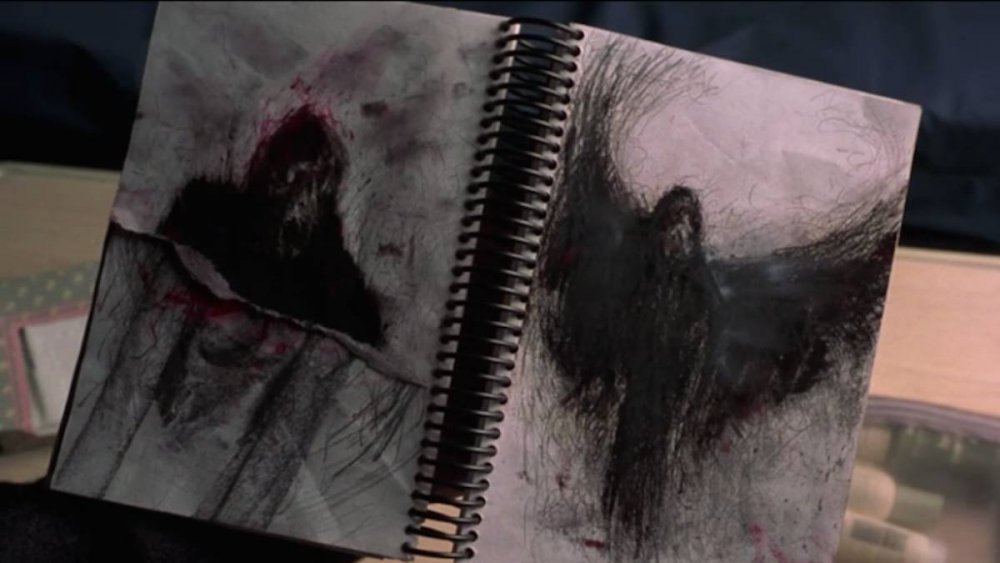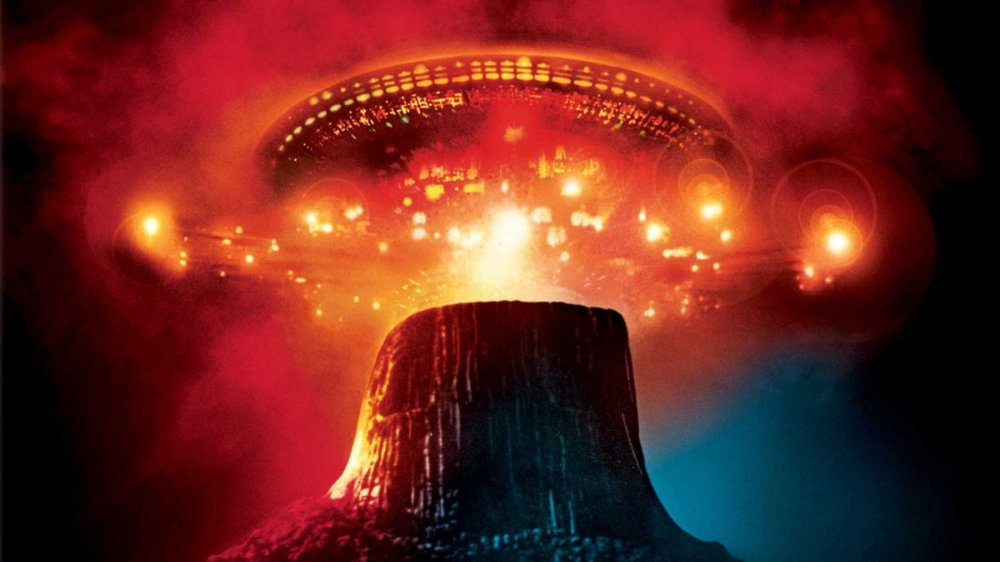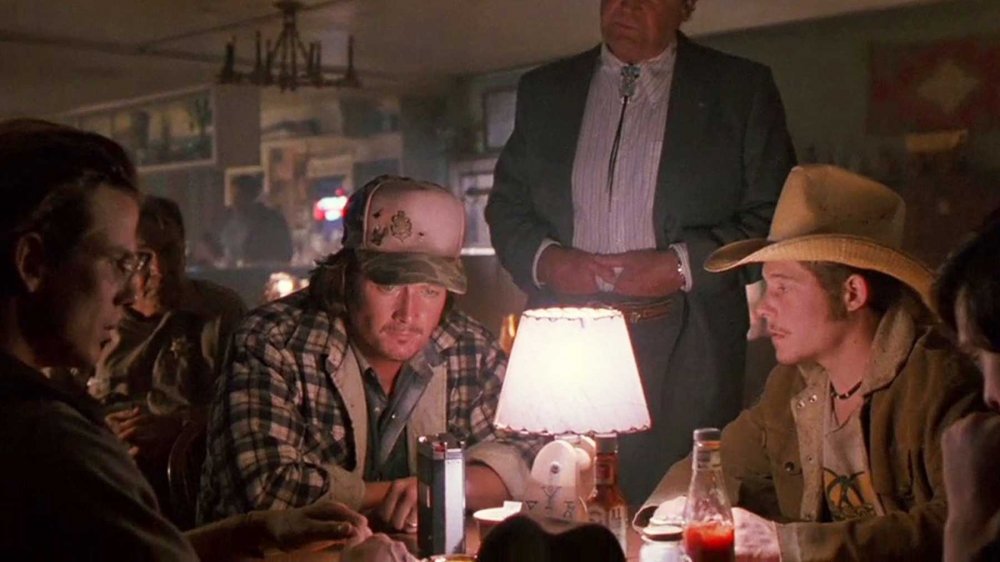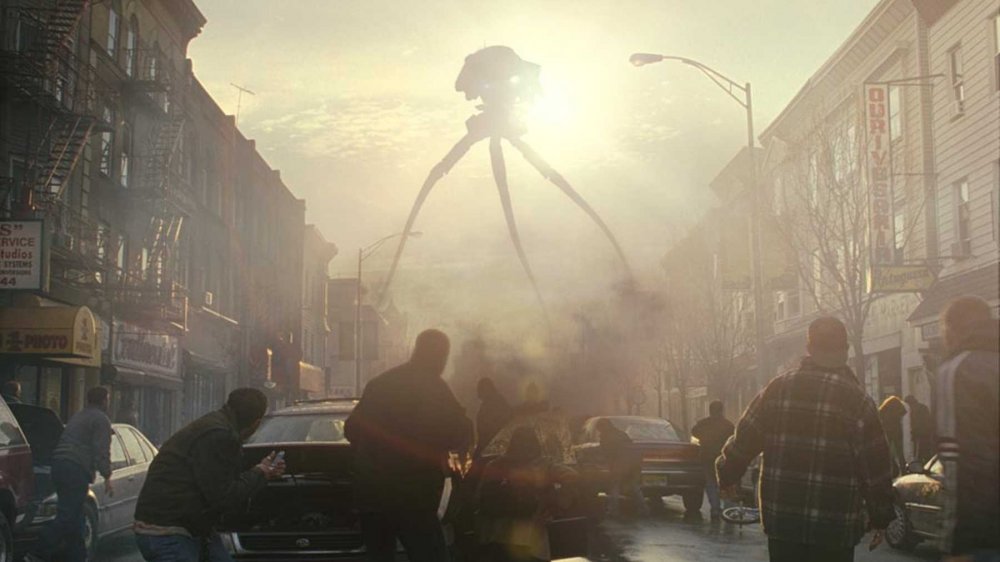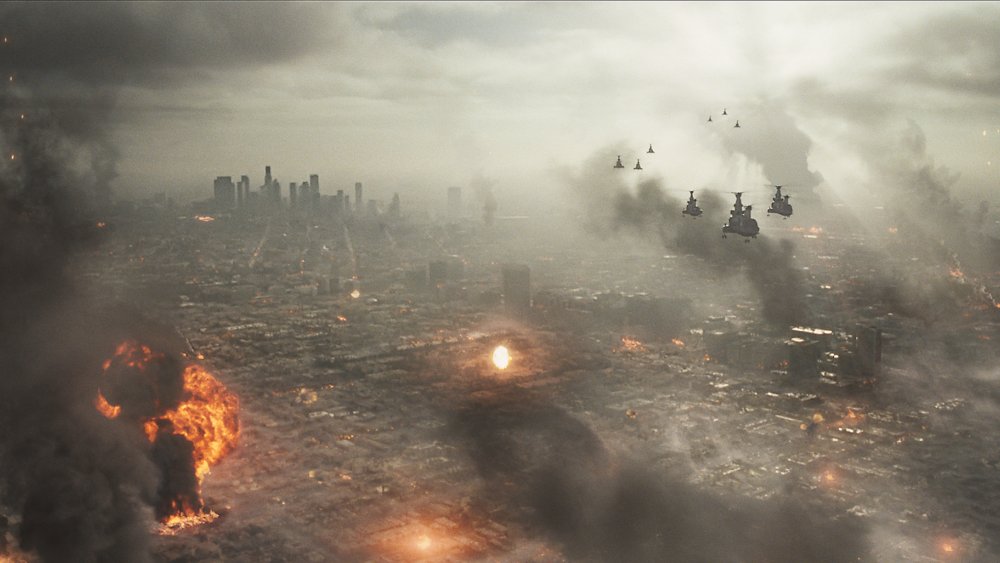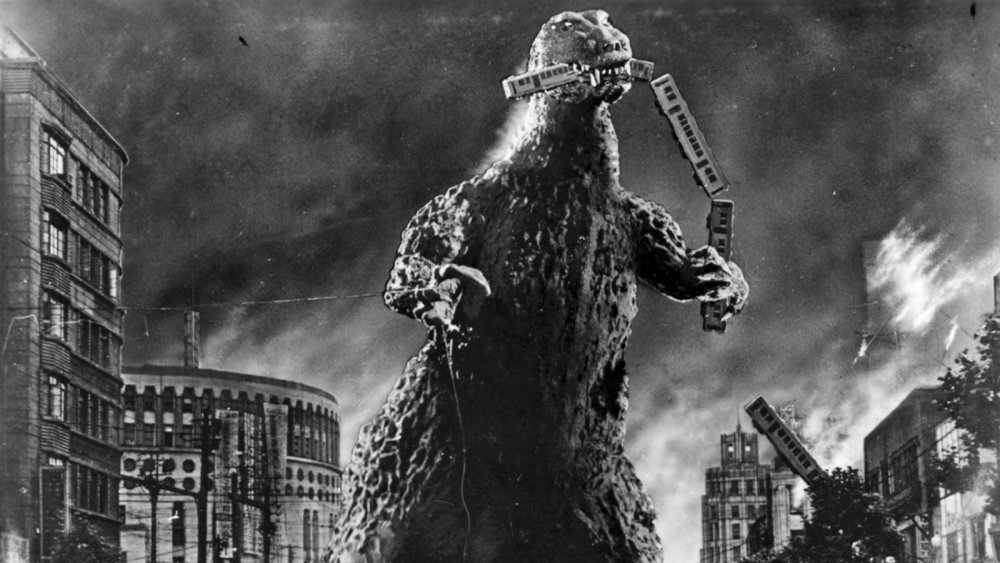Sci-Fi Movies Inspired By Real Life Events
Science fiction is the genre of possibility. Through fantastical tales of space exploration and sentient robots, writers, directors, and actors analyze society, advancing technology, and attempt to predict where the human race is headed. But don't be fooled — sci-fi movies aren't just about creatures, inventions, and events that have yet to exist. For as much as sci-fi loves to imagine the outlandish, it's a genre firmly rooted in real-world history.
Though some sci-fi movies play these nonfictional links down, others embrace them wholeheartedly. Overt allegories for nuclear war, racial bigotry, and technological advancement are everywhere in science fiction, and have even resulted in some of the greatest films of all time. Consider the work of Jules Verne, widely considered to be one of the fathers of science fiction as a whole: Journey to the Center of the Earth might tell an impossible story of cavemen and dinosaurs living within the planet, but it was inspired by actual scientific work of the time.
In that spirit, we're here to celebrate the best sci-fi movies inspired by real-world history. Get ready for searing tales of war, oppression, and invasion — and a whole lot of flying saucers.
District 9 is about South African apartheid
Neill Blomkamp delivered one of the best sci-fi stories of the 21st century with 2009's District 9. The film takes place in an alternate reality where a spaceship landed in South Africa in 1982. But these aliens weren't conquerors — they were starving. Since their arrival, the aliens have been confined to internment camps derided as unsightly slums. Everything changes when a human bureaucrat comes into contact with an alien substance that begins transforming him into a member of the mysterious extraterrestrial race. While the film will likely never get a sequel, much to fans' dismay, it stands on its own as a fascinating exploration of xenophobia and human empathy.
District 9 is openly rooted in the history of South Africa's apartheid system, particularly Cape Town's District Six neighborhood, from which 60,000 residents were forcibly removed in the 1970s. In one fell swoop, District Six went from being a cosmopolitan melting pot to being a "whites only" part of town. Former residents were relocated to Cape Flats, a barren, inconvenient, and shoddily built township many miles away.
Fortunately, South Africa formally repealed apartheid laws in 1991, and held its first election in which all citizens were able to take part in 1994. But as anyone who's watched Blomkamp's movie could tell you, that doesn't mean everything's fixed — and that's why it's a film we love.
The Blob is based off true accounts
The Blob chronicles the path of destruction an alien entity, crash-landed into rural Pennsylvania, leaves in its wake. And oh, is its particular brand of destruction something to behold: The blob devours everything in its path, including people, and grows constantly in size. It is appetite incarnate, and that's why it's an unforgettable movie monster.
As it turns out, the story of The Blob was taken from actual headlines. On September 26th, 1950, two Philadelphia police officers saw what appeared to be a parachute coming down from the sky. They drove over to the landing site — and were completely taken aback by what they found.
According to the report, the object was about six feet in diameter, and contained numerous crystals. It was purple in appearance and gave off a strange mist. One of the officers put his hand on the object and discovered an odorless sticky residue that thankfully did not begin to consume him. The object allegedly dissolved after 25 minutes. Though FBI agents were sent out, they arrived too late to see anything. It's tough to say if this actually happened — it was reported on locally, and picked up by national papers as a bit of a joke. But hey, at least we got a sci-fi classic out of it.
The Mothman Prophecies draws inspiration from a real tragedy
The Mothman Prophecies is a 2002 horror film about a reporter researching the myth of the Mothman. The reporter's wife died in a mysterious accident two years prior, and as he tracks down the monster, he finds himself reconnecting to his memories of her ... and, slowly but surely, discovering the truth of her death.
The true story the film is based on pretty much begs to be made into a movie. Throughout 1966 and 1967, residents of Point Pleasant, West Virginia reported sightings of a strange creature with dark wings, humanoid proportions, and glowing red eyes. On December 15th, 1967, the Silver Bridge connecting Point Pleasant to Gallipolis, Ohio collapsed, killing 46 people. Many people in the area blamed the mythic Mothman, though nowadays, we know poor maintenance was likely to blame. Still, the creature's reputation as a harbinger of death endures, cemented by author John Keel's 1975 book The Mothman Prophecies and its 2002 adaptation. No one knows exactly what those Point Pleasant townsfolk saw — but if you're in the area, be sure to check out the Mothman statue, Mothman Museum, and the spectacular annual Mothman Festival.
Close Encounters of the Third Kind drew from multiple sources
Close Encounters of the Third Kind follows a group of individuals who try to reach out to alien intelligence after mysterious UFO activity. While many sci-fi films draw inspiration from a singular event, Close Encounters actually takes inspiration from multiple sources: Actual people's experiences with UFOs.
To properly portray UFO sightings, Spielberg brought Dr. J. Allen Hynek onboard. Hynek was a ufologist, but don't think he was some sort of crank — Hynek was a world-renowned astronomer who developed the UFO classification system from which Close Encounters takes its title. Encounters of "the third kind" involve humans seeing visible occupants within a UFO.
Hynek began working with the US Air Force in 1948 as what he would eventually describe as "a debunker." In time, however, Hynek came to believe that UFO sightings couldn't necessarily be explained away as entirely mundane. The expertise he brought to Close Encounters showed: The film boasts such a high level of authenticity that NASA wrote a letter to Spielberg about the dangers of making such a detailed movie. Are aliens real? Could UFO sightings possibly be the result of creatures far beyond our current understanding, as Hynek theorized? No one knows ... but it sure does make for a great movie.
Fire in the Sky made a real life story horrifying
Fire in the Sky may have come out in 1993, but it still contains one of the freakiest alien abduction scenes ever put to film. That might be because it's drawn from an allegedly true story.
In 1975, a forestry worker by the name of Travis Walton was working as part of a crew near Snowflake, Arizona. Suddenly, a saucer-shaped craft came into their field of vision, emitting a high-pitched buzz. Walton approached the spacecraft, and was blasted by a tremendous energy beam. His coworkers ran away, assuming he was dead, but five days later, he showed up in town in a phone booth. He claims he was abducted by extraterrestrials who examined him in a hospital-like room. Fire in the Sky dramatizes this particular element of the abduction with queasy intensity.
Is the story true? Many consider it to be a hoax. Cognitive psychologist Susan Clancy has pointed out that Walton's account was one of many "abduction reports" made following a screening of TV movie The UFO Incident on NBC. Regardless, Walton maintains the truth of this tale to this day.
War of the Worlds gave the classic story a modern update
2005's War of the Worlds, based on the H.G. Wells novel from 1898, tells the story of an alien invasion that decimates the planet. Naturally, Wells' book isn't based on a real-life event, but director Steven Spielberg brought real-world inspiration to the fore in his cinematic spin on the classic sci-fi story. Specifically, 2005's War of the Worlds takes inspiration from the then-recent 9/11 attacks.
This is made evident early on in the film when an alien ship arrives near New York City and promptly devastates the surrounding area. The ship is merciless, attacking innocent people with an energy beam that blasts them into desiccated grey dust. Spielberg has openly discussed referencing the urban destruction seen by millions on 9/11: "It's certainly about Americans fleeing for their lives, being attacked for no reason, having no idea why they are being attacked and who is attacking them."
Battle: Los Angeles draws from another attack on American soil
Sci-fi thriller Battle: Los Angeles rolled into theaters in 2011. It chronicles a global alien invasion through the eyes of a platoon of Marines who try to protect L.A. from this new extraterrestrial threat. As you would expect, things don't go smoothly, and the platoon has to fight its way out of the city as it is ransacked by aliens.
The United States faced a different kind of surprise offensive in 1941 when Pearl Harbor was attacked. The country was in a state of disarray following the shocking event, and many in Los Angeles were particularly on edge, due to their proximity to Hawaii. This came to a head during the evening of February 24th, when strange objects began to appear in the sky above the city. Panicked, the U.S. Air Force responded with a barrage of anti-aircraft artillery. Three people died in the conflagration, and property damage was severe.
The official line on what was seen in the skies is that it was likely an errant weather balloon. Many remain unconvinced, to the point that Battle: Los Angeles was promoted through explicit linkage of the film to this historical event.
Overlord takes its name from a WWII operation
Overlord follows a group of U.S. soldiers who find themselves trapped behind enemy lines the day before D-Day. As they try to find a way out of the country, they discover fearsome Nazi experiments that bring people back from the dead in powerful new bodies. Clearly, it takes some liberties with the truth — Nazi zombies were not part of World War II. However, the film does take inspiration from some very real historical events.
The Nazis might not have possessed the ability to raise the dead, but they did conduct horrific scientific experiments on actual humans. Moreover, the regime really was interested in creating superior soldiers through strange scientific means. One drug, code-named D-IX, aroused particular excitement on the part of Nazi scientists, and has been described as specifically aimed at changing "the limits of human endurance."
Though zombies were never on the table, the Third Reich did contain parties interested in the occult, mysticism, and all things esoteric. Heinrich Himmler, one of the most powerful leaders of the Nazi Party and head of the SS, actually funded expeditions in search of ancient treasures of myth and legend, including the Holy Grail and Thor's hammer. Unsurprisingly, he didn't find them.
Phoenix Forgotten uses found footage to tell people about a real event
2017's Phoenix Forgotten follows three teenagers who set out to locate the source of a UFO phenomenon that took place in 1997 over Phoenix, Arizona. The event has become known as the "Phoenix Lights," and though the movie is fictional, the lights themselves were very real.
On March 13th, 1997, a set of mysterious lights were seen by residents of Phoenix. Thousands of people reported seeing the lights, which manifested in two distinct ways: As apparently stationary lights hovering over the city, and as lights flying across the area in a triangular formation. The stationary lights were explained as flares dropped by the Air Force as they performed various training exercises at a nearby facility. However, no explanation has been given for the triangular lights that were seen moving from Arizona to Nevada.
Were those lights actually alien spaceships? We may never know, but Phoenix Forgotten tries to fill in the blanks in horrific, found-footage style.
Godzilla is a creature of the nuclear age
Godzilla is one of the most enduring film franchises of all time. The 1954 movie that started it all still manages to impress, showcasing its giant monster wreaking havoc across Tokyo. Godzilla is the result of exposure to nuclear radiation, which caused him to grow to gargantuan proportions and develop powers like super-strength and "atomic breath." The film ends with the scientists using a machine known as the "oxygen destroyer" to take out the monster, which results in the destruction of the monster and the device. This ensures the device never falls into any military's hands.
On August 6th and 9th, 1945, the United States dropped two nuclear bombs onto the Japanese cities of Hiroshima and Nagasaki, respectively. Hundreds of thousands of people lost their lives in what remains the only use of atomic weapons in an armed conflict. Naturally, the country had a lot of trepidation about the nuclear arms race — concerns that manifested themselves in 1954's Godzilla. To this day, Godzilla remains a powerful metaphor for conflict, consequence, and nuclear destruction.
